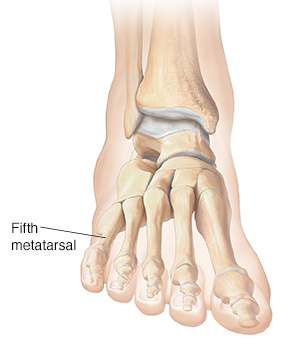Understanding Fifth Metatarsal Fracture
Understanding Fifth Metatarsal Fracture

How to say it
met-ah-TAHR-sal
What causes a fifth metatarsal fracture?
A direct blow to the bone is often the cause of a fracture of the fifth metatarsal. That may happen if you drop a heavy object on your foot or land wrong on your foot or ankle. Twisting activities can also break the bone. Pivoting while playing basketball is one example.
Repeatedly placing too much stress on the bone can also cause a fracture of the fifth metatarsal. This is called a stress fracture. People who do physical activities like dancing or running tend to be more prone to stress fractures.
Symptoms of a fifth metatarsal fracture
Sudden pain along the outside of your foot is the main symptom. A stress fracture may develop more slowly. You may feel chronic pain for a period of time. Your foot may also swell up and bruise. You may have trouble walking.
Treatment for a fifth metatarsal fracture
Treatment for this type of fracture depends on where the bone is broken and how severe the breakage is. Healing can take up to several months. Treatment may include:
Cold therapy. Putting ice on the area may reduce swelling and pain, especially in the first few days after injury.
Elevation. Propping up the foot so it is above the level of your heart may ease swelling.
Prescription or over-the-counter pain medicines. These help reduce pain and swelling.
Immobilization. Devices such as a splint, cast, or walking boot can protect the bone and ease pain. They can help keep the bone in place so it heals properly. You may need to avoid putting any weight on the broken bone for a period of time. Severe fractures usually need a longer limit on weight-bearing activities.
Stretching and strengthening exercises. Certain exercises can help you regain flexibility and strength in your foot.
Surgery. You usually will not need surgery. But you may need it if the bone is broken into 2 or more pieces and is not aligned (displaced), doesn’t heal properly, or takes a long time to heal.
Possible complications of a fifth metatarsal fracture
The bone doesn’t heal correctly
Acute compartment syndrome. This is when pressure builds up in the muscles of the foot and affects blood flow.
When to call your healthcare provider
Call your healthcare provider right away if you have any of these:
Fever of 100.4°F (38°C) or higher, or as directed
Symptoms that don’t get better, or get worse
Numbness or coldness in your foot
Toe nails that turn blue or grey in color
New symptoms
Updated:
March 21, 2017
Sources:
Alsobrook J, Hatch RL. Proximal fifth metatarsal fractures. UpToDate. June 16 ed: UpToDate; 2014. p. 30., Aman SV, Cooper MT. Metatarsal Fractures In: Miller MD, Hart JA, MackNight JM, editors. Essential Orthopaedics; 2010. p. 829-31., Hatch R, Clugston JR. Metatarsal shaft fractures. UpToDate. August 5 ed: UpToDate; 2015., Reider BC, et al. Fifth Metatarsal Fracture. In: Reider BC, et al, editors. Orthopaedic Rehabilitation of the Athlete. Philadelphia: Saunders; 2015. p. 1552-70., Safran MR, Zachazewski J, Stone DA. Metatarsal Fracture (Including Jones and Dancer's Fractures). In: Safran MR, Zachazewski J, Stone DA, editors. Instructions for Sports Medicine Patients. 2 ed. Philadelphia: Saunders; 2012. p. 643-7., Smith MS. Metatarsal Fractures. In: Eiff MP, Hatch R, editors. Fracture Management for Primary Care. 3 ed. Philadelphia: Saunders; 2012. p. 299-318.
Reviewed By:
Bellendir, Trina, MSPT, CLT,Image reviewed by StayWell medical illustration team.,Joseph, Thomas N, MD